The calcitonin receptor (CT) is a G protein-coupled receptor that binds the peptide hormone calcitonin and is involved in maintenance of calcium homeostasis,[5] particularly with respect to bone formation and metabolism.[6][7][8]
CT works by activating the G-proteins Gs and Gq often found on osteoclasts, on cells in the kidney, and on cells in a number of regions of the brain.[9] It may also affect the ovaries in women and the testes in men.
The function of the CT receptor protein is modified through its interaction with Receptor activity-modifying proteins (RAMPs), forming the multimeric amylin receptors AMY1 (CT + RAMP1), AMY2 (CT + RAMP2), and AMY3 (CT+ RAMP3).[10]
Preclinical studies have suggested that dual amylin and calcitonin receptor agonists may be more effective than amylin receptor agonists for obesity and type II diabetes.[11]
- ^ a b c GRCh38: Ensembl release 89: ENSG00000004948 – Ensembl, May 2017
- ^ a b c GRCm38: Ensembl release 89: ENSMUSG00000023964 – Ensembl, May 2017
- ^ "Human PubMed Reference:". National Center for Biotechnology Information, U.S. National Library of Medicine.
- ^ "Mouse PubMed Reference:". National Center for Biotechnology Information, U.S. National Library of Medicine.
- ^ Purdue BW, Tilakaratne N, Sexton PM (2002). "Molecular pharmacology of the calcitonin receptor". Receptors & Channels. 8 (3–4): 243–255. doi:10.1080/10606820213681. PMID 12529940.
- ^ Chambers TJ, Magnus CJ (January 1982). "Calcitonin alters behaviour of isolated osteoclasts". The Journal of Pathology. 136 (1): 27–39. doi:10.1002/path.1711360104. PMID 7057295. S2CID 8395420.
- ^ Dacquin R, Davey RA, Laplace C, Levasseur R, Morris HA, Goldring SR, et al. (February 2004). "Amylin inhibits bone resorption while the calcitonin receptor controls bone formation in vivo". The Journal of Cell Biology. 164 (4): 509–514. doi:10.1083/jcb.200312135. PMC 2171986. PMID 14970190.
- ^ Davey RA, Turner AG, McManus JF, Chiu WS, Tjahyono F, Moore AJ, et al. (August 2008). "Calcitonin receptor plays a physiological role to protect against hypercalcemia in mice". Journal of Bone and Mineral Research. 23 (8): 1182–1193. doi:10.1359/jbmr.080310. PMC 2680171. PMID 18627265.
- ^ senselab Archived February 28, 2009, at the Wayback Machine
- ^ "Calcitonin Receptors: Introduction". IUPHAR Database of Receptors and Ion Channels. International Union of Basic and Clinical Pharmacology. Archived from the original on 2016-03-03. Retrieved 2008-12-12.
- ^ Sonne N, Karsdal MA, Henriksen K (April 2021). "Mono and dual agonists of the amylin, calcitonin, and CGRP receptors and their potential in metabolic diseases". Molecular Metabolism. 46: 101109. doi:10.1016/j.molmet.2020.101109. PMC 8085567. PMID 33166741.





